The Best Protein Bars: The Tastiest And Healthiest Options
They’re not cheap and can contain more calories and sugar than chocolate bars. Choose wisely with our expert guide and top picks
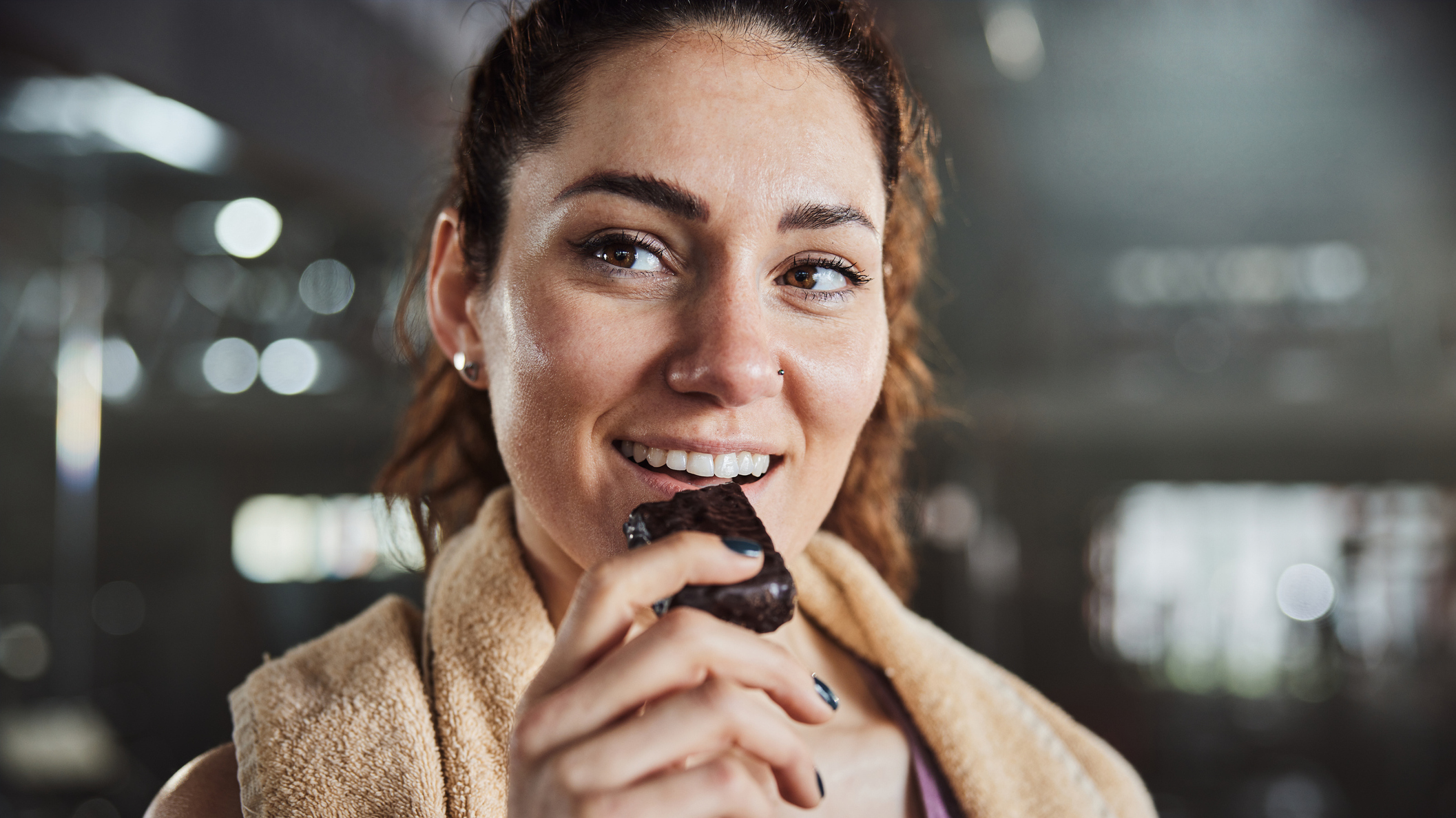
Protein is so much more convenient these days. Where once gym-goers had to tuck into a couple of rotisserie chickens to refuel their muscles after a hefty workout, they can now mix up a protein shake or, more convenient still, tuck into a protein bar.
These are now widely available, involve zero preparation, and the best protein bars taste good enough to seem like a treat as well as a way to help build muscle. However, there are downsides, mainly involving the diamond-hard texture and artificial flavour of some, and you can’t assume all are a healthier snack bar – some very much aren’t.
That’s what we discovered when we spoke to Kurtis Frank from nutrition and supplement encyclopaedia examine.com for expert advice on what to look for when buying protein bars. The entire conversation is further down the page, but in brief, the first thing to check is the ratio of protein to calories – 15g of protein in a 200-calorie bar or 25g in a 250-calorie bar are good yardsticks. If you can find a bar you like the taste of with a decent amount of fibre, that’s also a welcome bonus. Make sure the carbs are low too, although if you’re an endurance athlete looking for a pre-session snack to top up your glycogen stores, try one of the best energy bars instead.
Frank recommends being sensitive to price as well, because on a cost-per-calorie basis protein bars can be surprisingly expensive. Of course, go too cheap and the taste and especially texture will suffer. “Whether or not it can be used as a brick cannot easily be conveyed through the label,” says Frank. “It will ultimately require some taste testing to find out which ones can break a window when thrown.”
Fearing for your teeth, we bravely chomped our way through as many as possible. In some cases, that really did take a lot of bravery, but that does mean we’ve weeded out the duds and we feel confident that if you stick to our list of the best protein bars your teeth will remain uncracked.
Of course, a varied diet is always preferable so make sure you don’t come to rely too heavily on protein bars. You can mix things up (literally) with the best protein powders or best vegan protein powders, but nothing can compare to the advantages of eating high-protein foods instead of protein supplements.
The Best Protein Bars
You can trust Coach
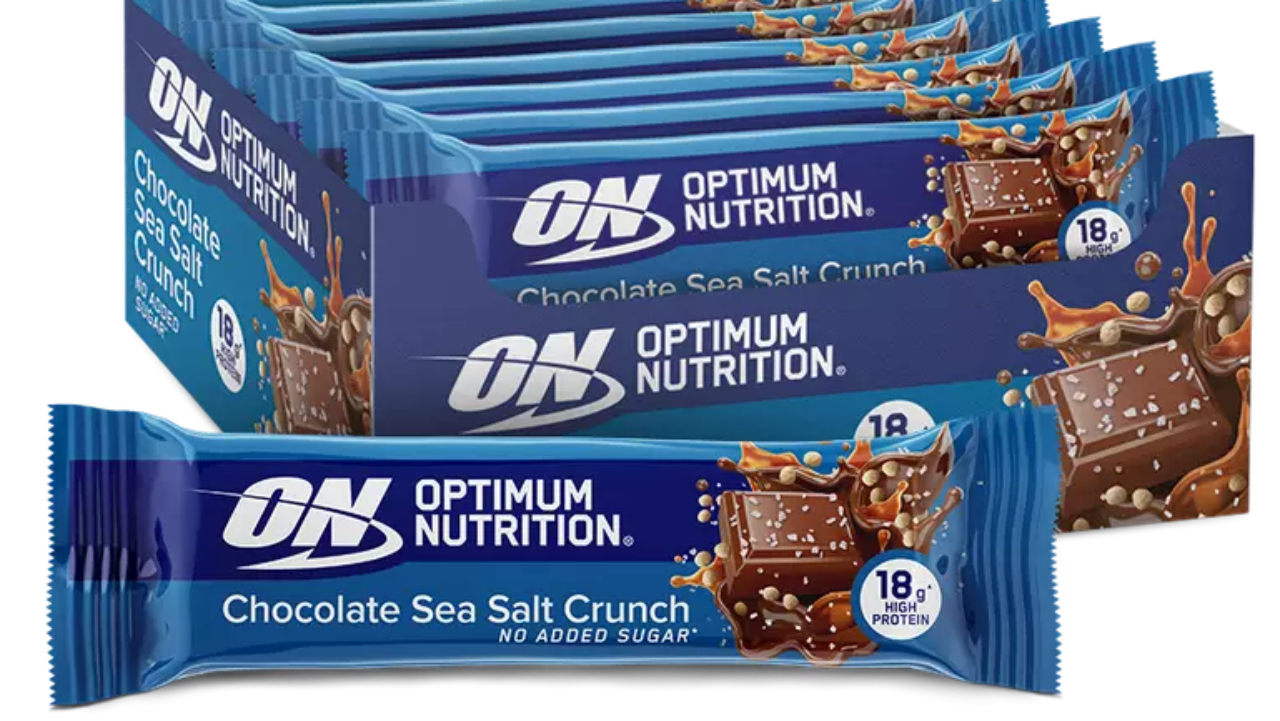
1. Optimum Nutrition Protein Bar
Specifications
Reasons to buy
Reasons to avoid
Our favorite flavor: Chocolate sea salt crunch
For me, it’s a race between this Optimum Nutrition bar and Grenade’s Oreo option for the title of “best-tasting protein bar on the market”. It’s rich and indulgent, providing a ready-made substitute for an actual chocolate bar if you’re looking to make more nutritious switches in your diet. Even the aftertaste is enjoyable, something I’ve found to be a rarity among protein bars.
The fine details: It’s not just the flavor that earns this protein bar a glowing review. It has a decent macro profile too, with lower values for fat (10g), carbs (20g) and sugar (1.9g) than most competitors I’ve tried. With 221 calories, it sits within the “average” bracket among protein bars, and the 18g serving of protein is solid without being anything to write home about.
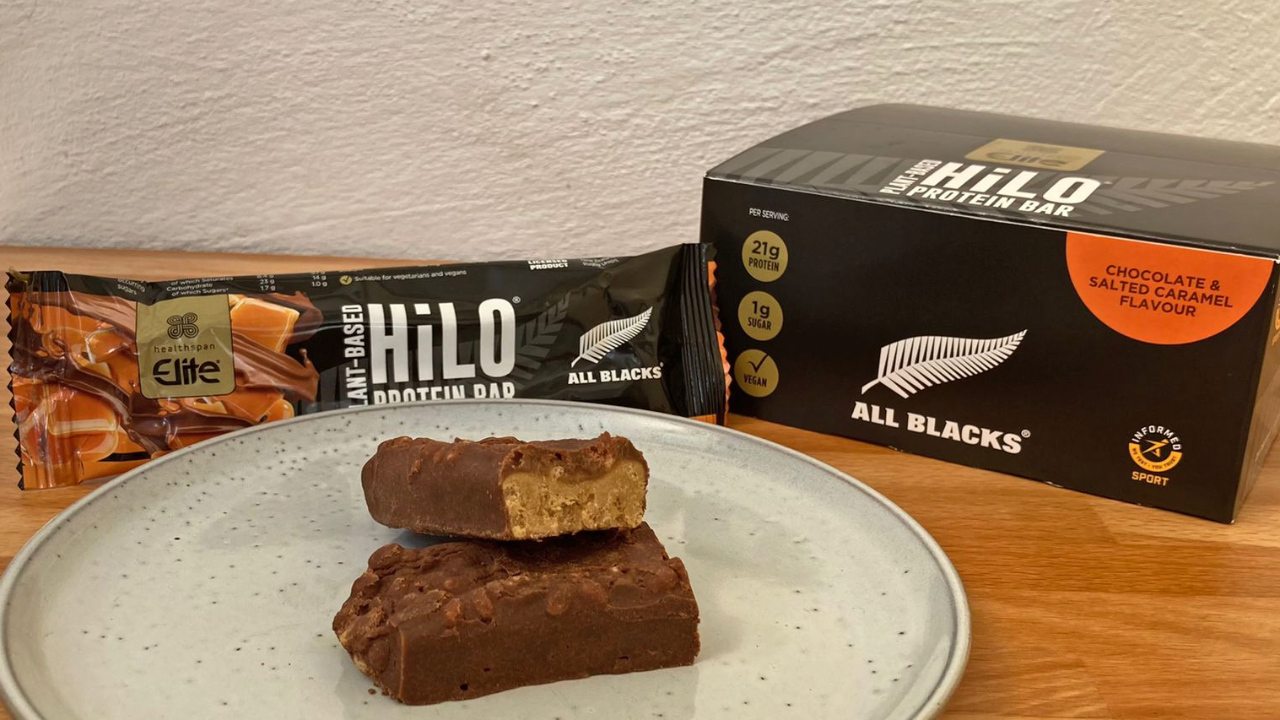
2. Healthspan Elite All Blacks Plant-Based HiLo Protein Bar
Specifications
Reasons to buy
Reasons to avoid
Our favorite flavor: Chocolate and salted caramel
Vegan protein bars, like their plant-based powder counterparts, can often be tasteless and grainy. This Healthspan bar bucks the trend. It has a generous helping of a caramel substitute on top of its protein-rich fudge-like center, all wrapped in a thin layer of chocolate. The result is a bar that’s richer than many vegan options. The bars can be a little dry and there remains a hint of grainy aftertaste, but it’s still an enjoyable sweet treat.
The fine details: This HiLo bar does exactly what it promises: It delivers high amounts of protein and minimal sugar. In each bar, you’ll get a solid protein serving of 21g, as well as a 14g carb hit, 11g of fat and 1.2g of sugar.
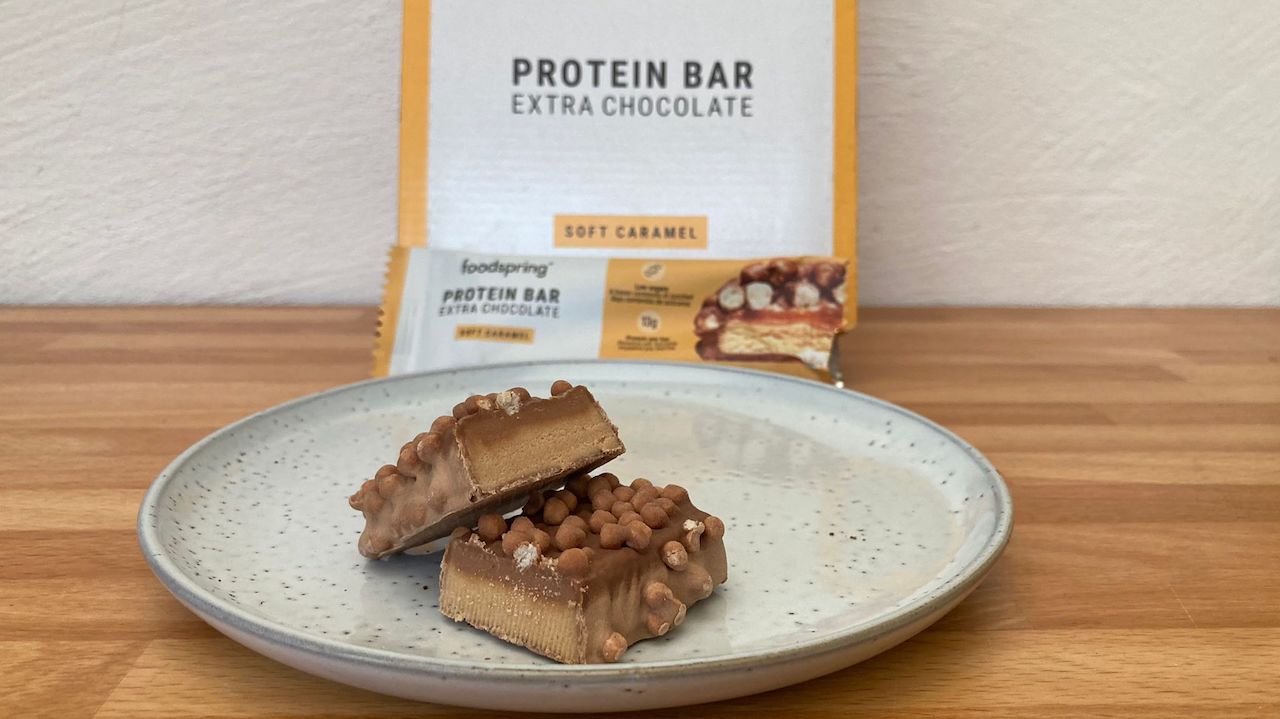
3. Foodspring Protein Bar
Specifications
Reasons to buy
Reasons to avoid
Our favorite flavor: Soft caramel
This won’t give you the same 20g protein hit as rivals like Optimum Nutrition and Grenade, but these bars do provide a flavorsome low-sugar option. Having tried all five flavor options I emerged with two clear favorites—soft caramel and double chocolate cashew. The soft caramel was the runaway winner, with a chocolate exterior and Malteser-like balls topping a caramel and nougat-esque filling. This layered approach delivered a winning texture and satisfying levels of sweetness post-workout. However, if you don’t have such a sweet tooth, the dark chocolate and cashew combo is more likely to float your boat.
The fine details: While the protein content is nothing to write home about, just look at that barely-there sugar content—0.4g, the lowest we’ve found! Maltitols are the chief sugar substitutes, with the sweetener sucralose also appearing further down the ingredient list.
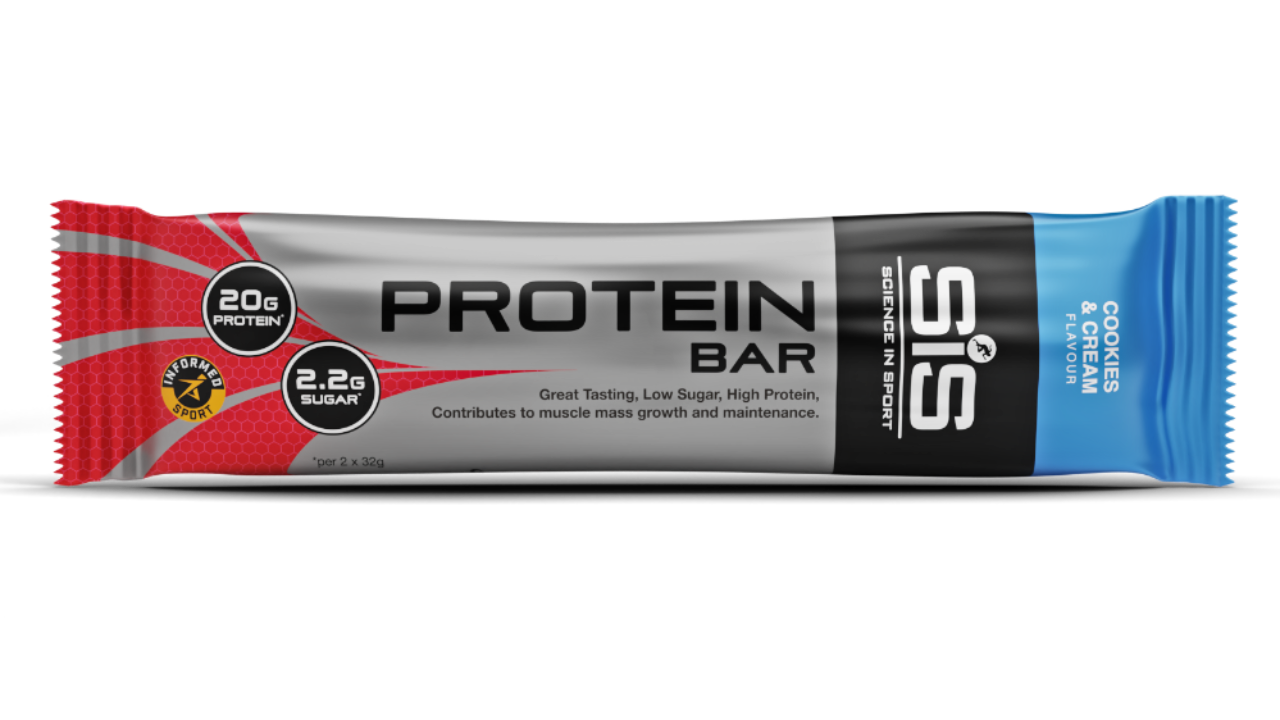
4. Science In Sport Protein Bar
Specifications
Reasons to buy
Reasons to avoid
Our favorite flavor: Cookies and cream
I tried two flavors—dark chocolate and raspberry, and cookies and cream—and while the former’s quick hit of raspberry was pleasant, the latter blew it away on the taste front. It delivered the sweet hit you want from a dessert-flavored snack bar, with a milky cookie taste and a texture that made it easy to eat. It comes in two 32g portions too, which I appreciated because it allowed me to eat one and stash the second half away for later in the day.
The fine details: At 20g per 64g serving (both snack portions in the packet), the protein provision is enough to rank the SiS bar with the best of them. The carb (24g), fat (12g) and calorie numbers are a little higher than average, but it maintains a low sugar content of 2.2g.
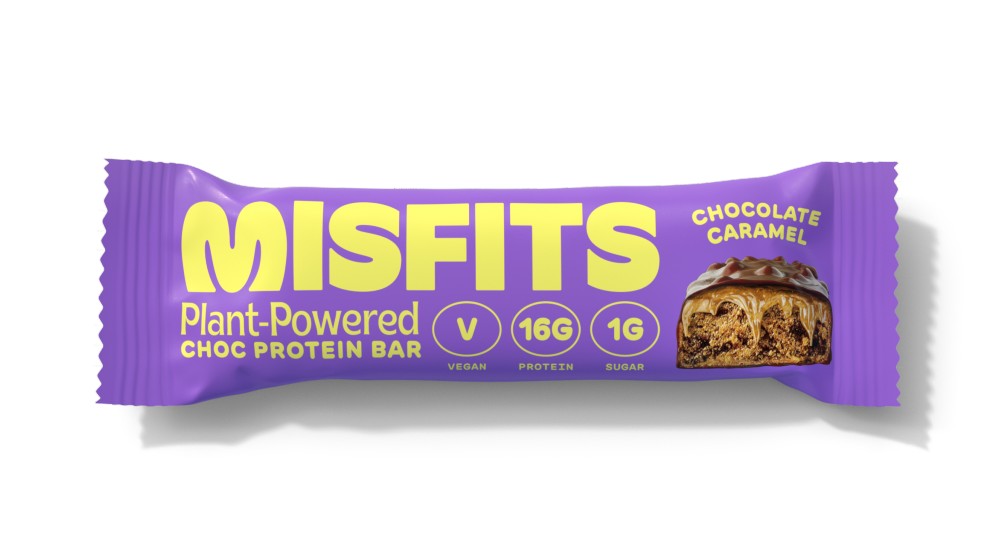
5. Misfits Protein Bar
Specifications
Reasons to buy
Reasons to avoid
Our favorite flavor: Chocolate caramel
The caramel in this vegan bar means that it easily avoids the common protein bar problem of being too dry, and the overall flavor is rich without being too sweet. Taste and texture both get a big tick from us, and the other flavor we tried—chocolate hazelnut—is almost as good, just a bit drier.
The fine details: Misfits knows what’s good about the bar and broadcasts it in huge digits on the front of the packaging. There’s 16g of protein (in the chocolate caramel bar, 15g in other flavors) in each 45g bar, and under 1g of sugar. The amount of protein is a little light compared with some other options, but the calorie count is also low at 186, and the hidden bonus is the massive 8g of fiber each bar also contains.—NHF
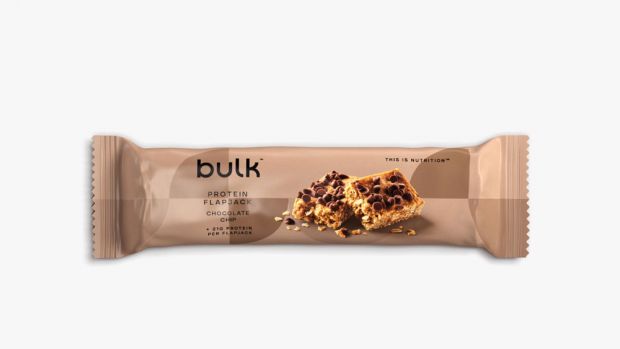
6. Bulk Protein Flapjack
Specifications
Reasons to buy
Reasons to avoid
Our favorite flavor: Chocolate chip
This beast of a bar is one to use after intense workouts when you need a generous helping of protein, carbs and calories to help your body recover. It’s not going to replace the sheer joy of biting into a real chocolate chip flapjack, but it is a satisfying snack loaded with a lot more protein than you’d get from a standard flapjack.
The fine details: Each 85g bar contains 21g of protein, 32g of carbs and 337 calories. There’s also a pleasing 7.6g of fiber, with oats helping to beef up that number, but watch out for the sugar here—at 12g per bar it’s higher than you’ll find in most other options on this list.—NHF
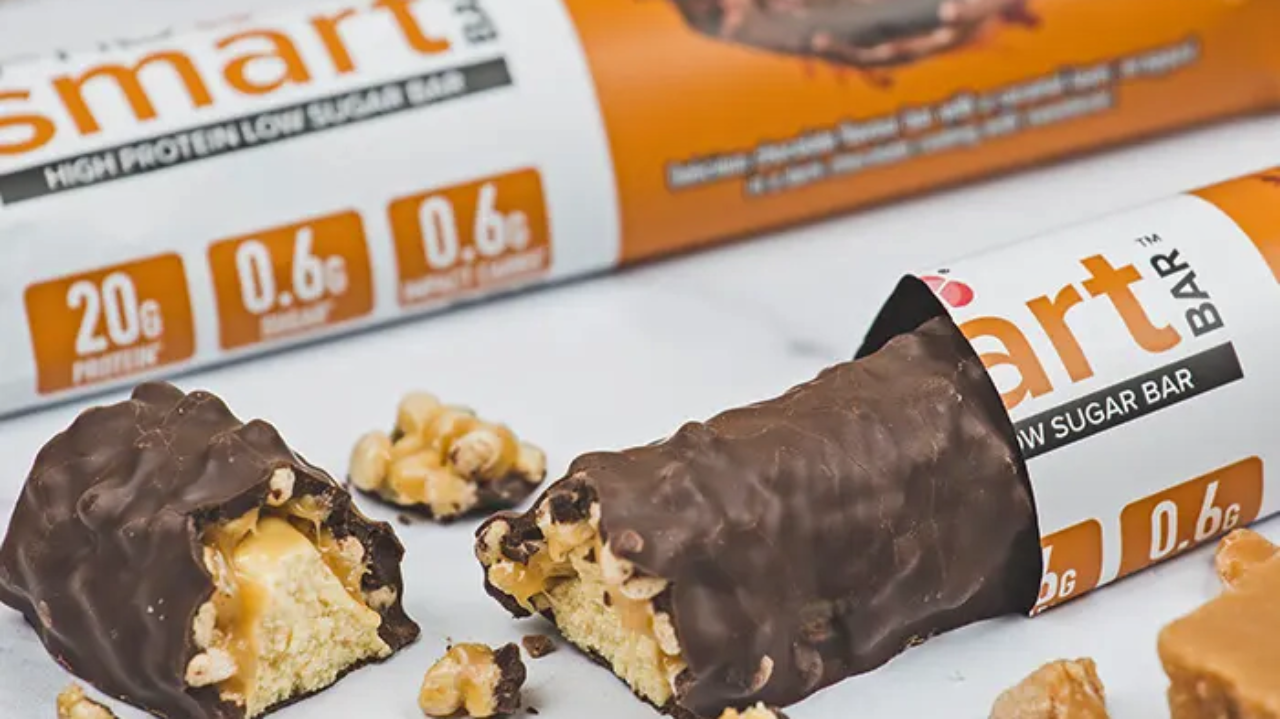
7. PhD Smart Bar
Specifications
Reasons to buy
Reasons to avoid
Our favorite flavor: Caramel Crunch
I tried this alongside PhD’s chocolate brownie Smart Plant Bar and the original Smart Bar was the clear flavor winner. The taste wasn’t overwhelming, but the addition of a thin caramel layer on top of the creamy, fudgy center did give it a light quality. This isn’t the bar to reach for when you want to satisfy a serious sweet craving, but the subtle flavors make it a good fit for a more regular post-workout protein top-up.
The fine details: The first thing I look out for on bars like these is a protein content of 20g or more—and it's a “yes” to that. Then it’s time to look at the carbs, fats, sugars and calories (23g, 12g, 1g and 256, respectively). All, aside from the sugar, are a little higher than most of the bars I’ve tried before, but the overall balance is still solid.

8. Veloforte Protein Bar
Specifications
Reasons to buy
Reasons to avoid
Our favorite flavor: Forza
The Forza is hands down the best-tasting protein bar I’ve come across, which means I'm prepared to overlook its downsides, like the high price and relatively low protein content at 12g per bar. This all-natural bar contains a winning blend of apricots, almonds and fennel, and if the word fennel puts you off, try the mix of hazelnuts, coffee and cocoa in Veloforte’s Mocha bar instead.
The fine details: The Forza bar contains three times more carbs than protein with 38.3g of the former (and 27.3g of sugar), making it a better pick for endurance athletes seeking to refuel after a long training session than weightlifters looking for a pure protein punch. It also contains 7.4g of fiber.
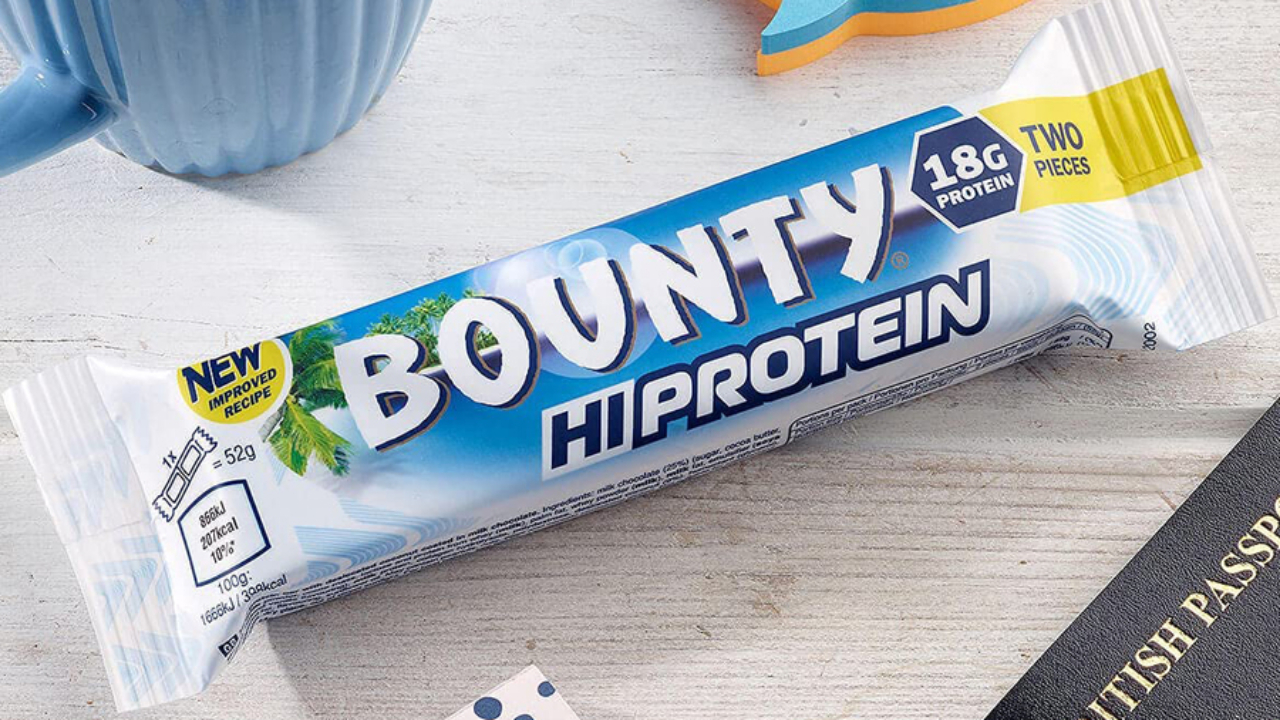
9. Bounty Hi Protein Bar
Specifications
Reasons to buy
Reasons to avoid
A number of protein bar versions of well-known chocolate snacks have been released in the UK. The M&M bar was a hit. The white chocolate Snickers a miss. The Bounty bar marks a return to form and even has a valuable lesson for the rest of the industry: desiccated coconut hides a multitude of sins. Not that the rest of this bar gets much wrong. The center is gooey, rather than chewy, there’s a milk chocolate casing, and in a move which will keep traditionalists happy, there are two mini bars in each pack.
The fine details Part of the reason coconut tastes so delicious is that it’s so fatty, so you’re using up a third of your daily recommended allowance of saturated fat if you polish off the pack. Artificial sweeteners aren’t used so sugars are also comparatively high at 8g. With all that going on, it’s impressive that 18g of protein was squeezed into a 207-calorie bar. Like the M&M bar, this is a treat with a protein bonus, rather than a healthy staple. But who doesn’t like a bonus with their treat?
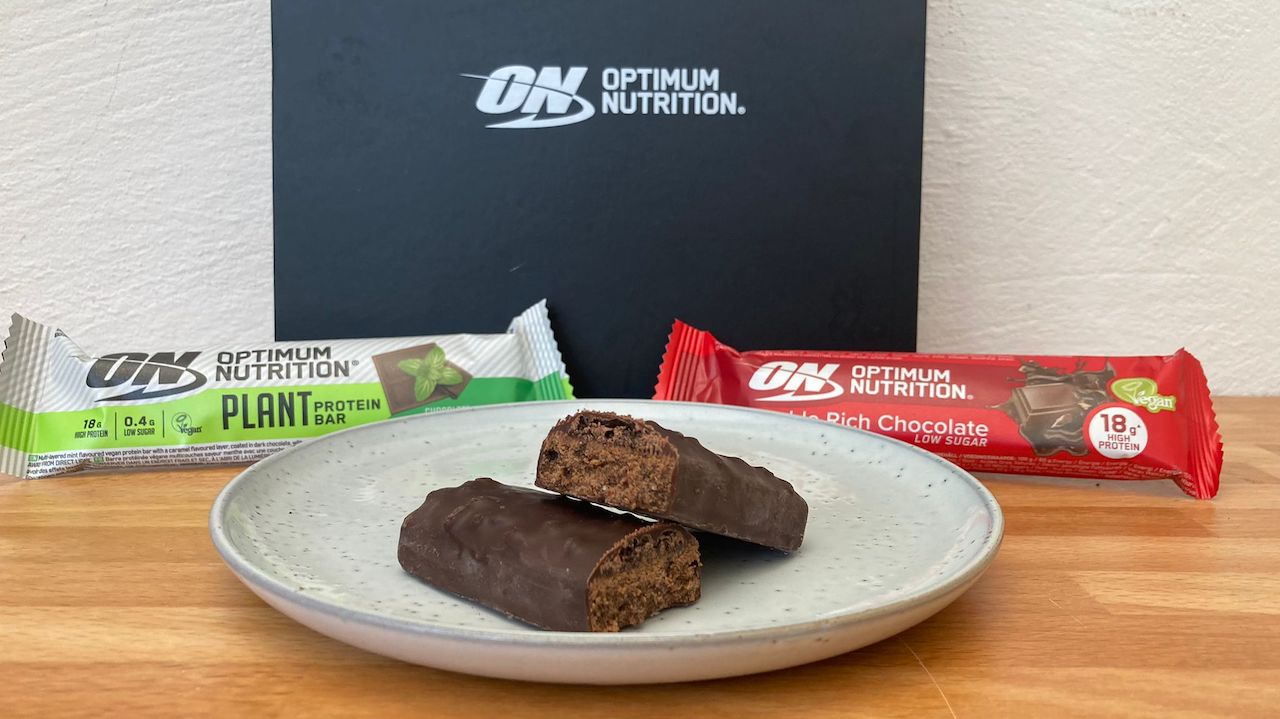
10. Optimum Nutrition Plant Protein Bar
Specifications
Reasons to buy
Reasons to avoid
Our favorite flavor: Chocolate mint
If you’re going to buy the Optimum Nutrition Plant Bar, I’d recommend plumping for the chocolate mint snack over the double rich chocolate flavor (the only two options). I found the latter didn’t deliver on its decadent promises, but the chocolate mint bar delivered great taste not unlike an After Eight. It’s less showy than the caramel-laden sweetness of many competitors too, giving it a more understated taste that I enjoyed on the walk home from my daily workouts.
The fine details: This vegan-friendly bar is a decent all-rounder, offering 18g of protein and 222 calories in each 60g bar. It’s also a great option for anyone who’s lactose intolerant, saving your stomach unnecessary stress. The fat and carb levels are higher than you might like if you’re looking for a post-gym hit of pure protein, but endurance and hybrid athletes may appreciate this balanced macro profile.—HB
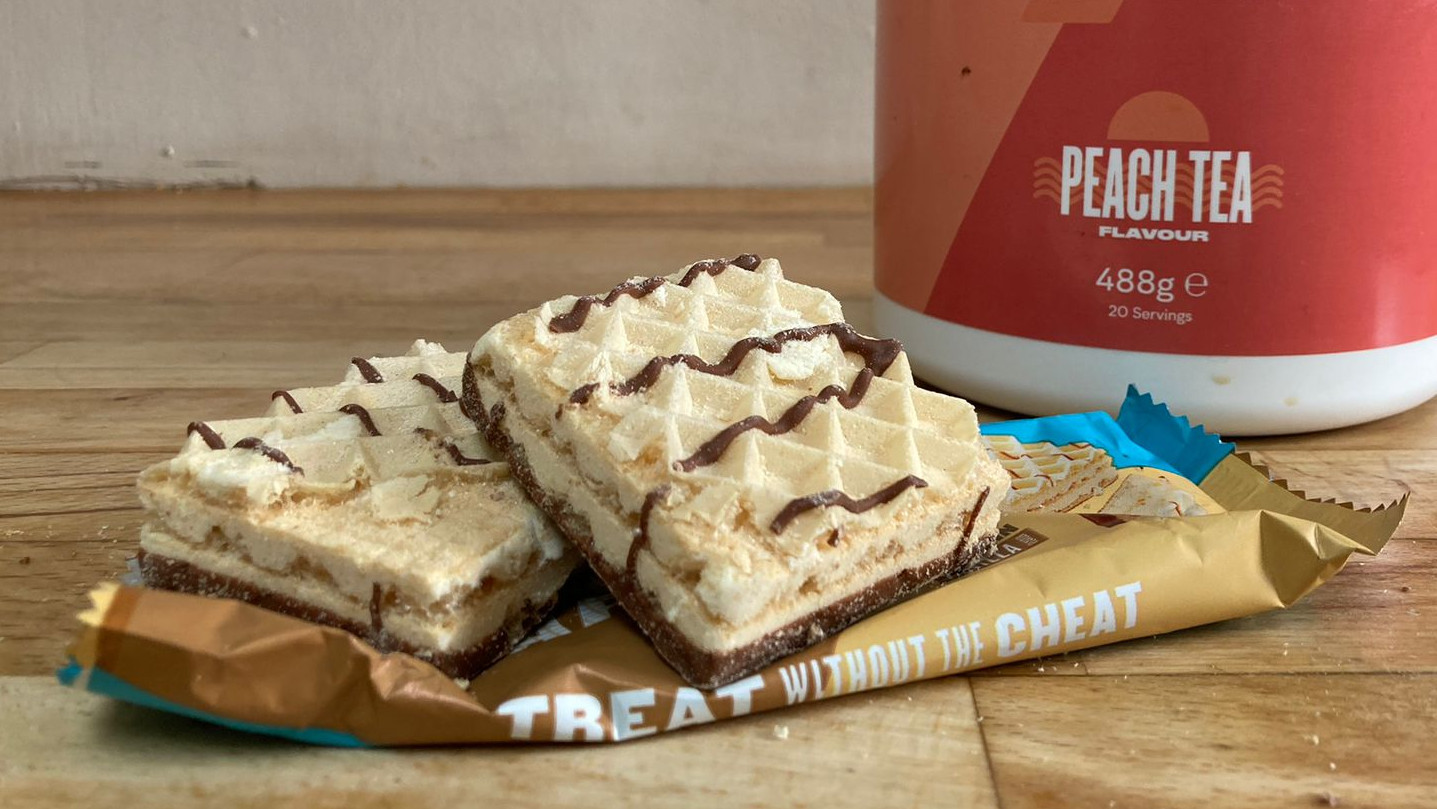
11. Myprotein Crispy Wafers
Specifications
Reasons to buy
Reasons to avoid
Our favorite flavor: Chocolate hazelnut
Write-up: If you’re sick of the jaw ache that comes from eating chewy protein bars, this is the snack for you. It offers the same 15g protein hit as Myprotein’s more traditional protein bars like the Crispy Layered and Lean Layered protein bars, but delivers it in lighter, tastier and arguably more fun wafer form. A word to the wise, though: If you’re eating this crumbly bar at your desk, don’t expect to do it neatly.
The fine details: The protein-to-calorie ratio is a little underpowered compared with the standard recommended by Frank, but 15g of protein is still nothing to sniff at. The sugars are a middling 5.5g, but the fat content is high at 9g and there’s zero fiber.
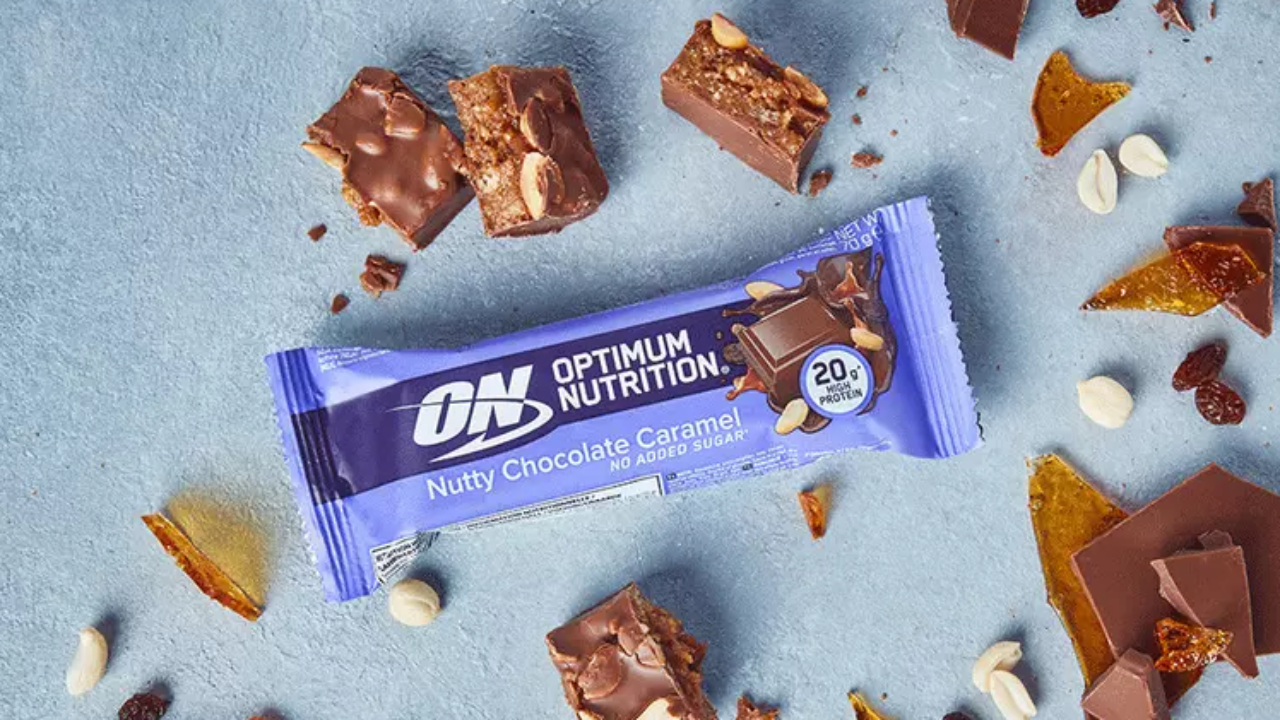
12. Optimum Nutrition Nutty Chocolate Caramel Protein Bar
Specifications
Reasons to buy
Reasons to avoid
Our favorite flavor: Nutty Chocolate Caramel
Once you’ve tried one protein bar, you’ve tried them all, right? Well, apparently not. This Optimum Nutrition option breaks the status quo, with real raisins and peanuts sprinkled throughout to give it a flavor and texture reminiscent of Rocky Road (or tiffin, for any fellow Brits). Not only is this a nice change from the usual formula, it’s also enjoyable in its own right.
The fine details: Despite the extra ingredients, this bar doesn’t overstep the macro mark. Its 20g of protein makes it a great post-workout snack, and it keeps sugars to a minimum. Given the fullness of its flavor, I was also pleasantly surprised to find there were only 16g of carbs and 6.7g of fat per serving.
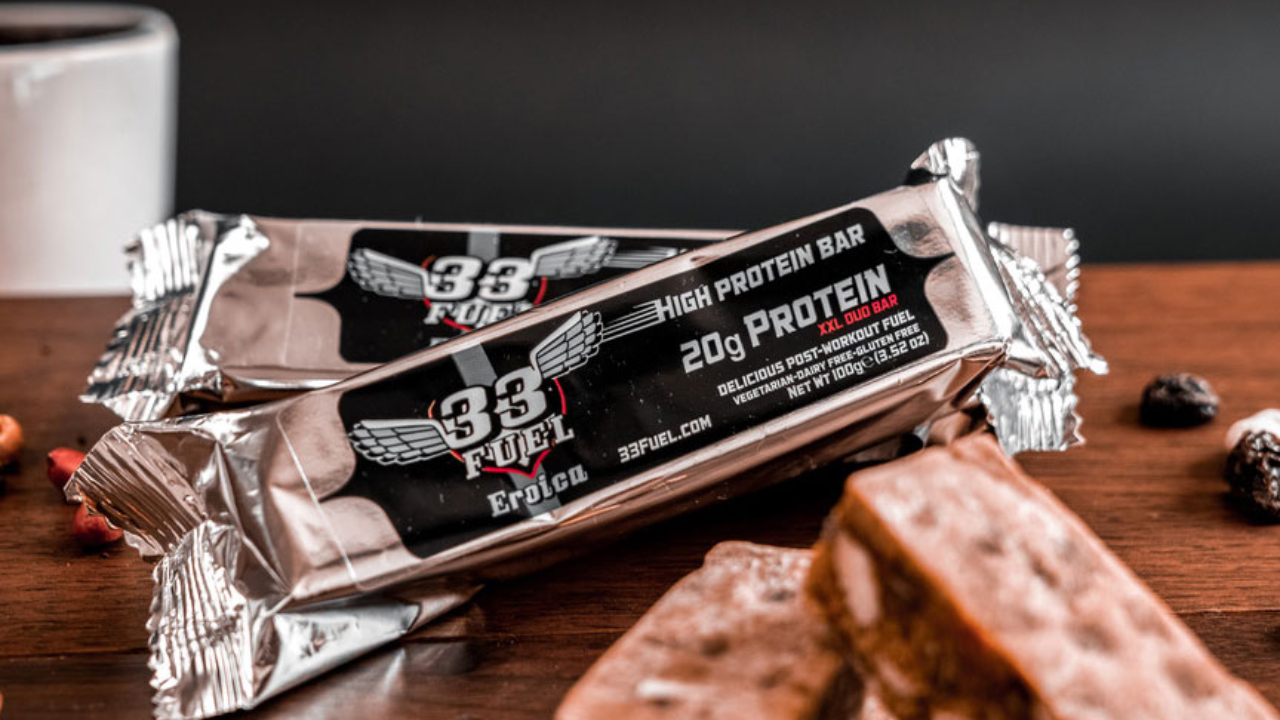
13. 33Fuel Eroica Protein Bar
Specifications
Reasons to buy
Reasons to avoid
Our favorite flavor: Eroica
This is an excellent all-round protein bar, especially for endurance athletes or anyone not especially worried about their carb and sugar intake. It’s one of the only bars that comes close to being as delicious as Veloforte’s Forza bar, since it’s also made from natural ingredients like nuts and candied peels, and it contains more protein at 20g per double-bar pack. However, it’s expensive – those all-natural bars go easier on your stomach than they do on your wallet.
The fine details: The substantial 100g pack contains an awful lot of stuff besides that 20g of protein, and some will be alarmed at the 38g of sugar and 409 calories per pack. It’s high in carbs too, at 43g per pack, and there’s 17g of fat (of which 1.47g is saturates). This is very much a bar for fuelling high-energy pursuits, but it tastes so good you’ll gladly put the work in to justify it.
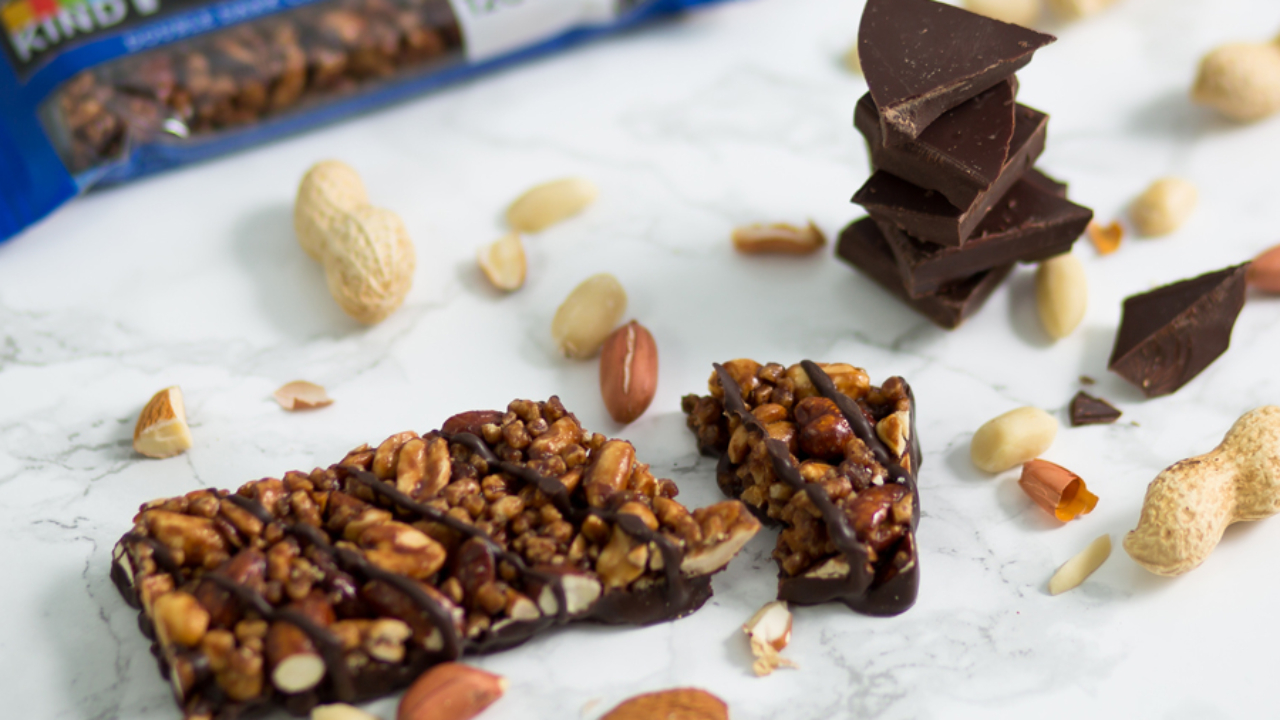
14. KIND Protein Bar
Specifications
Reasons to buy
Reasons to avoid
Our favorite flavor: Double Dark Choc Nut
They’re not as high in protein as others on this list, but KIND bars are a genuine treat, full of nuts and dark chocolate This particular bar is made from peanuts, almonds and dark chocolate, so obviously it is very nice. We challenge anyone to make a bar that tastes bad using those three primary ingredients.
The fine details: The protein levels are just 12g per 50g bar, although the fibre count is high at 4.9g. They’re also pretty high in fat at 17g per bar, even if most of that is the “healthy” unsaturated kind. Essentially they lean towards the treat category, with the extra protein content being a bonus.

15. Grenade Oreo Protein Bar
Specifications
Reasons to buy
Reasons to avoid
Do you like Oreos? Do you want a snack with a healthy 21g hit of protein? If you answered yes to both, your prayers have been answered. This delicious bar has bits of real Oreo crumbled into the center alongside soft chocolate and nougat layers that give it an enjoyably soft and chewy texture much like a Mars bar. Sweet treat aficionados will be able to tell the difference, but in my opinion this is among the closest you’ll come to a protein snack that could pass as a chocolate bar.
The fine details: As mentioned above, each 60g bar delivers 21g of protein and just 1g of sugar. The flavor is amazing, but this does come at the expense of some fairly high carb, fat and saturated fat levels (20g, 10g and 5.6g respectively).
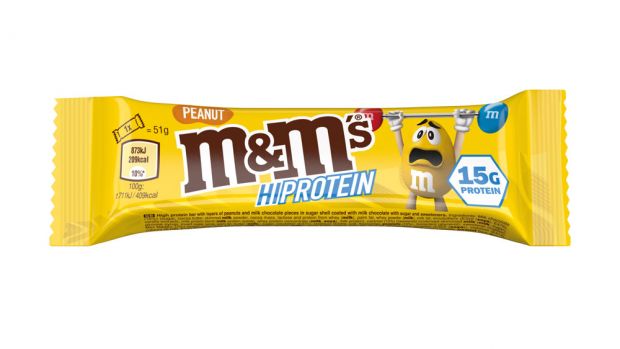
16. M&M’s Hi Protein Chocolate Bar
Specifications
Reasons to buy
Reasons to avoid
Our favorite bar: Chocolate
As people increasingly turn to protein bars as slightly healthier snacking alternatives to chocolate bars, it’s only natural that traditional chocolate brands are aiming to get in on the action. The M&M’s protein bar is not quite as tasty as the chocolate-centred sweet itself, but it is satisfyingly chocolatey and contains large M&M chunks. The texture was hard to judge because we left these on a counter during a heatwave, so presumably they’re not usually quite so liquified, but there were no signs of any stodginess.
The fine details: There are two flavours of the bars—chocolate and peanut—and both contain 15g of protein, which is a solid enough amount for a 51g bar. The peanut bar is a little higher in calories at 207 compared with the chocolate flavour’s 192. However, the sugar levels are high at 15g per bar, half of your daily recommended maximum and significantly more than you’ll find in most protein bars, which tend to use artificial sweeteners instead. That puts these bars firmly in the occasional treat camp, but they’re still a little healthier than going full chocolate.
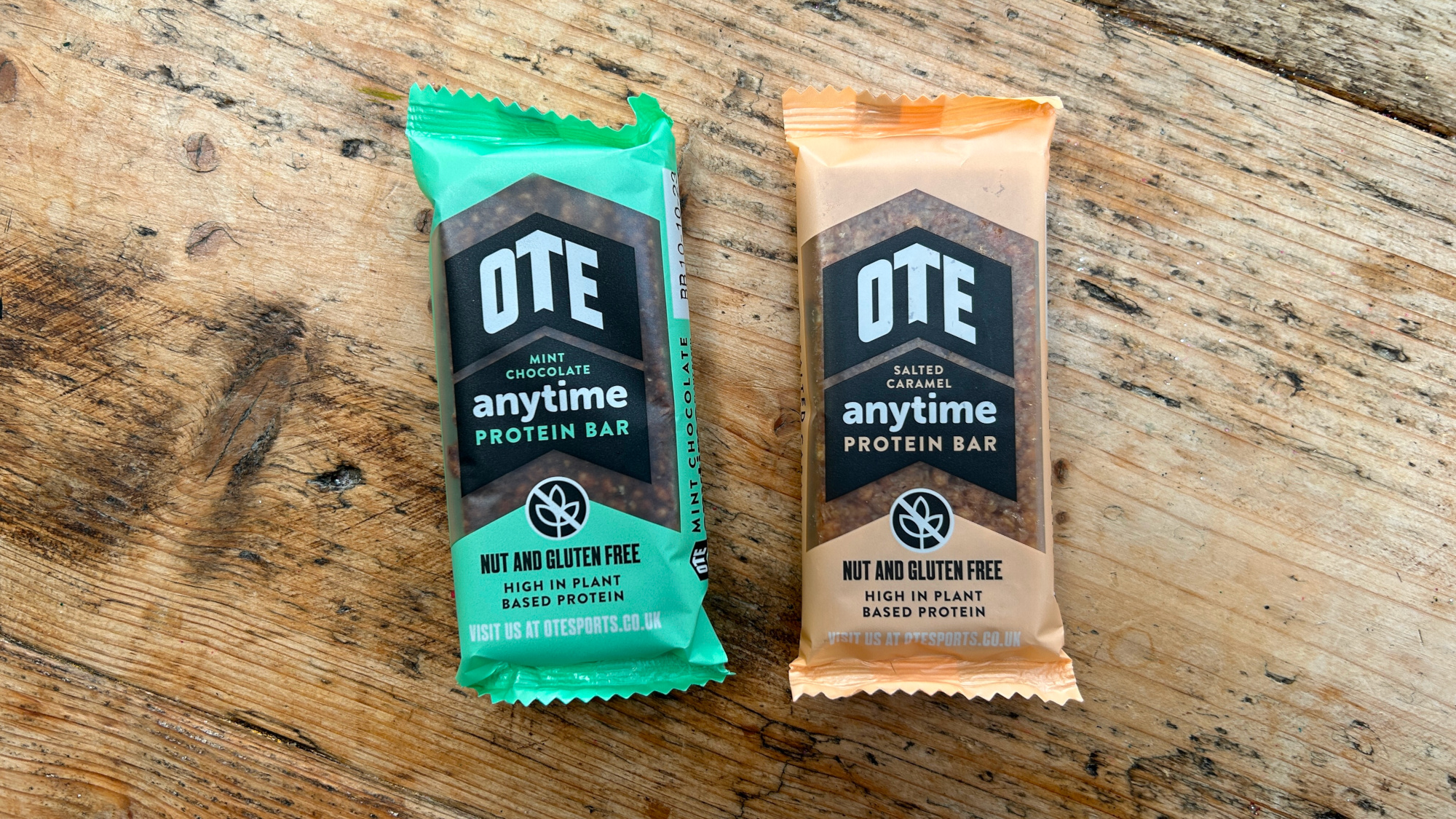
17. OTE Anytime Protein Bar
Specifications
Reasons to buy
Reasons to avoid
Our favorite flavor: salted caramel
There are two flavors: mint chocolate and salted caramel. The former is an acquired taste but the salted caramel bar will appeal to many. The pleasing chewy-flapjack texture makes it satisfying to wolf down after a hard session or just as a mid-afternoon pick-me-up.
The fine details: The OTE Anytime Bar isn’t as packed with protein as other options, with 11g in each bar, but it does contain 26g of carbohydrates. It’s the perfect snack for after long runs or rides when you need to replenish your energy.—NHF
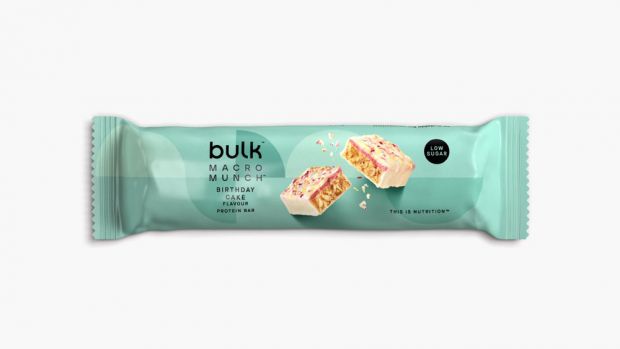
18. Bulk Macro Munch
Specifications
Reasons to buy
Reasons to avoid
Our favorite flavor: Brilliant Birthday Cake
Bulk has, somewhat ambitiously, decided to call these gourmet protein bars, which creates an expectation that any bar is going to struggle to meet. We like that the bar has sprinkles on top, and some kind of jam-style layer that adds to the ersatz cake experience. The texture also delivers, avoiding excessive chewiness. It’s a great protein bar – just don’t call it gourmet.
The fine details: Each 62g bar contains 233 calories and 20g of protein, with the sugar count kept low at 2.9g through the use of isomalt and sucralose sweeteners. The list of ingredients is dismayingly long, although to be fair the sprinkles are a surprisingly large part of that. There’s a nice surprise at the end of the nutritional info though—the 8.7g of fiber in each bar.
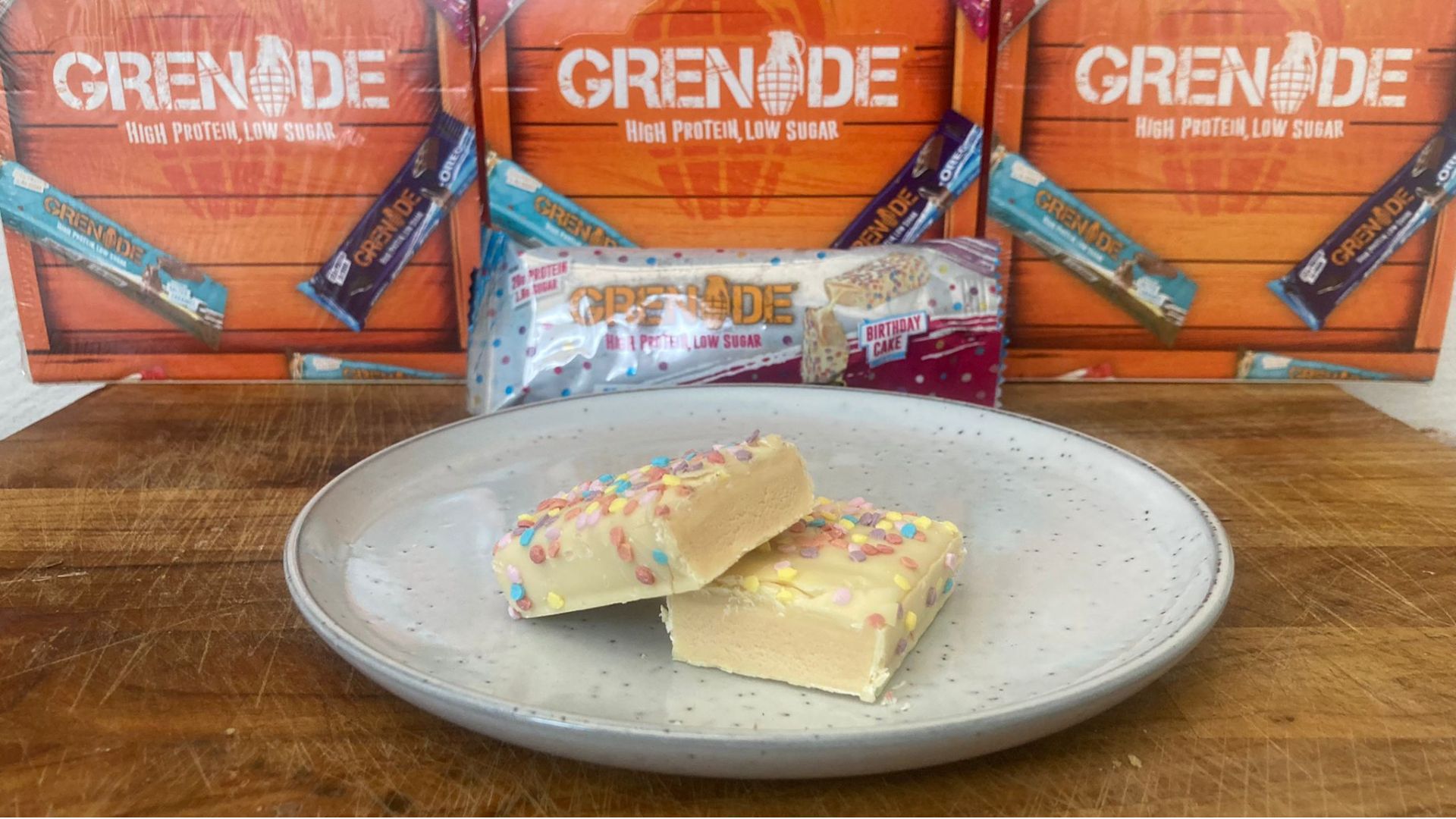
19. Grenade Protein Bar
Specifications
Reasons to buy
Reasons to avoid
Our favorite flavor: Birthday Cake
Grenade makes great protein bars, but recently I set out to see which of its products tastes the best. It’s a tough job, but somebody’s gotta do it. And, after weighing up every bar the brand has to offer, (excluding the Oreo collab featured above) I settled on its Birthday Cake option. The vanilla flavor had me feeling eight years old and ready to blow out some candles, while the colorful textured topping adds an enjoyable crunch.
If that doesn’t sound like your bag, fear not. There’s a vast array of other flavors including Chocolate Chip Salted Caramel, Peanut Nutter, Fudged Up, Dark Chocolate Mint, Dark Chocolate Raspberry, Caramel Chaos, Jaffa Quake, Lemon Cheesecake and so on. The texture is pleasant, consisting of a fudgy base topped with a gooey layer and something crunchy on top.
The fine details:
Grenade delivers on its promise of whipping up high-protein, low-sugar bars: This one has 20g of the former and 1.6g of the latter—it’s sweetened instead with maltitol. As with the Oreo option, the carb (21g) and calorie (212) totals are a bit higher than other brands, but it’s still a delicious snack to reach for rather than your go-to confectionary.
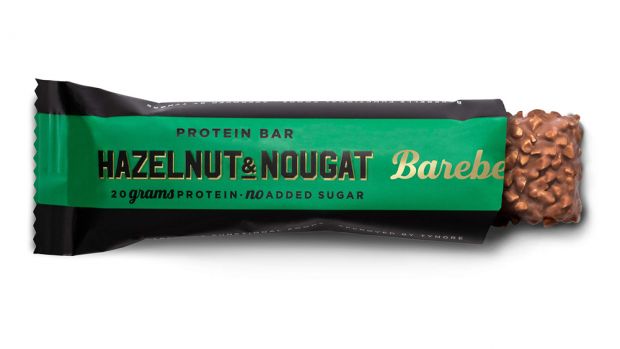
20. Barebells Protein Bar
Specifications
Reasons to buy
Reasons to avoid
Our favorite flavor: Hazelnut & Nougat
They say a picture is worth a thousand words, but Barebells’ design is worth precisely one – “lifestyle”, with a premium 1950s Americana look that’s undeniably alluring. We initially found the flavors a bit of a let-down—that is, until Barebells released the Hazelnut & Nougat bar, which is very tasty indeed. The texture is spot-on too, with an enjoyable level of chewiness that doesn’t stray into the cardboard-style consistency of some protein bars.
The fine details: It’s another of the new breed of bars with very low sugar, just 1.9g, and with 20g of protein in just 205 calories it’s punching above its weight. There’s also a respectable 4.2g of fiber per 55g bar.
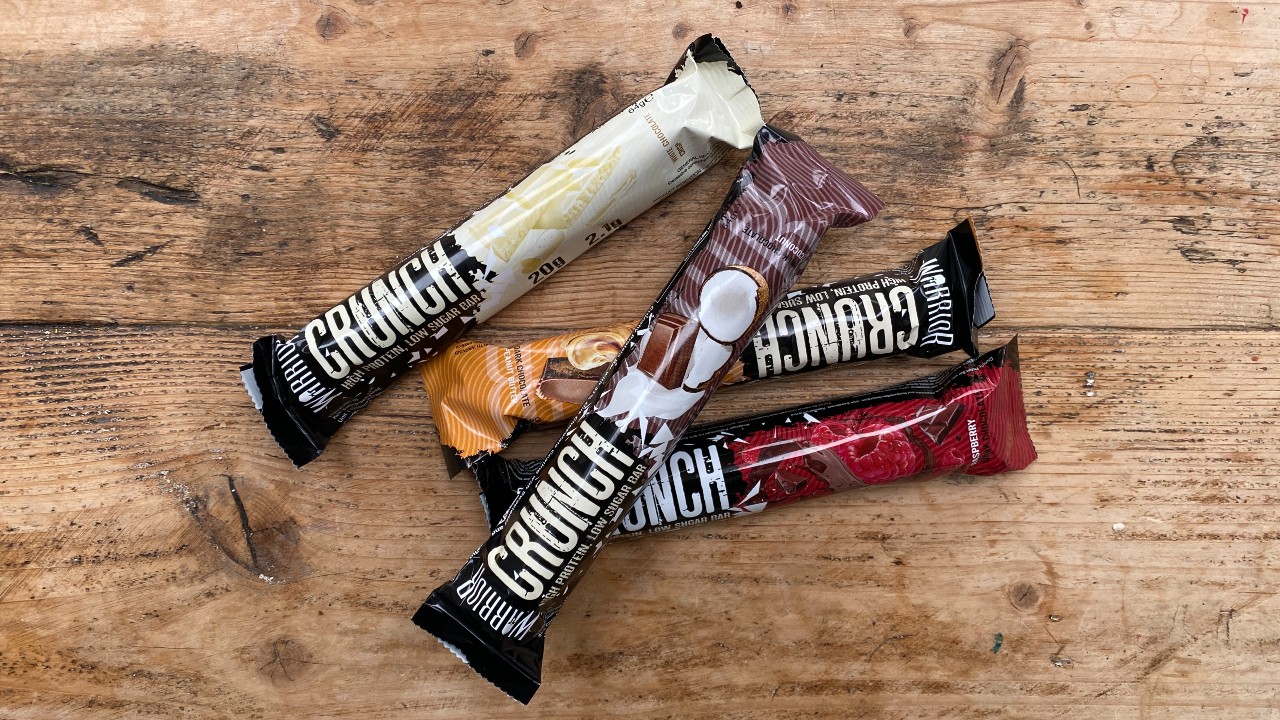
21. Warrior Crunch Protein Bar
Specifications
Reasons to buy
Reasons to avoid
Our favorite flavor: Raspberry Dark Chocolate
No doubt aware that many people dislike the chewy consistency of many protein bars, Warrior has made its bar as crunchy as possible, and stuck “crunch” in the name to hammer the point home. The multi-layer bars satisfy in terms of both taste and texture, with the raspberry dark chocolate and key lime pie flavors being stand-outs.
The fine details: There’s a hefty serving of both protein (20g) and carbs (24g) in each bar, but the sugar content is low at 2.3g, with malitol used as a sweetener. Each bar is fairly fatty, containing 11g with 6.1g of that saturated fat.—NHF
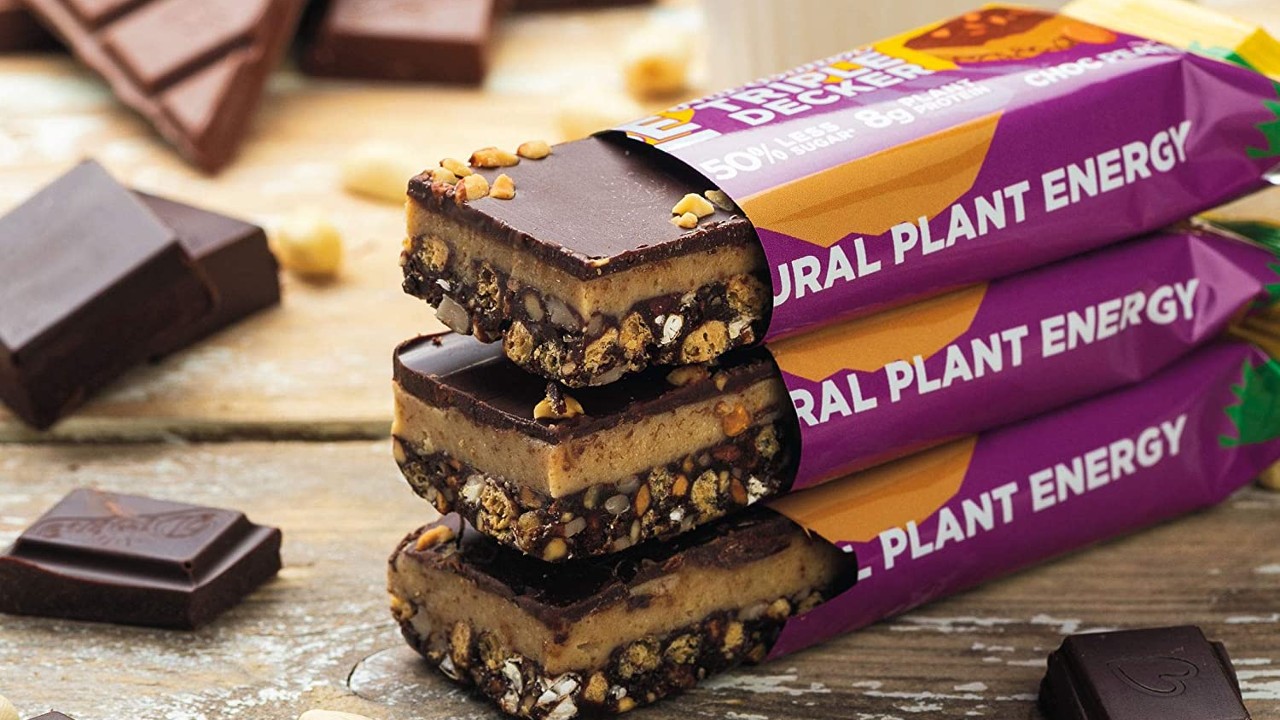
22. Tribe Triple Decker
Specifications
Reasons to buy
Reasons to avoid
Our favorite flavor: Vegan Honeycomb
There are three layers in these vegan bars, and all three hit the mark. The topping is chocolate—hard to go wrong there—the middle is nut butter, and the base is crunchy granola. The texture is spot on, and the flavors are excellent too. This is a proper snack.
The fine details: All the tasty goodness above might have tipped you off that the nutritional stats are not going to be perfect. The bars are small at 40g, but even so only getting 8g of protein makes them an outlier on this list, especially as you get more carb (9.6g) and fat (12g) per bar. The fiber content is pretty good at 3.2g, though, and while 5.8g of sugar isn’t a tiny amount, it’s less than you usually find in natural bars like this.—NHF
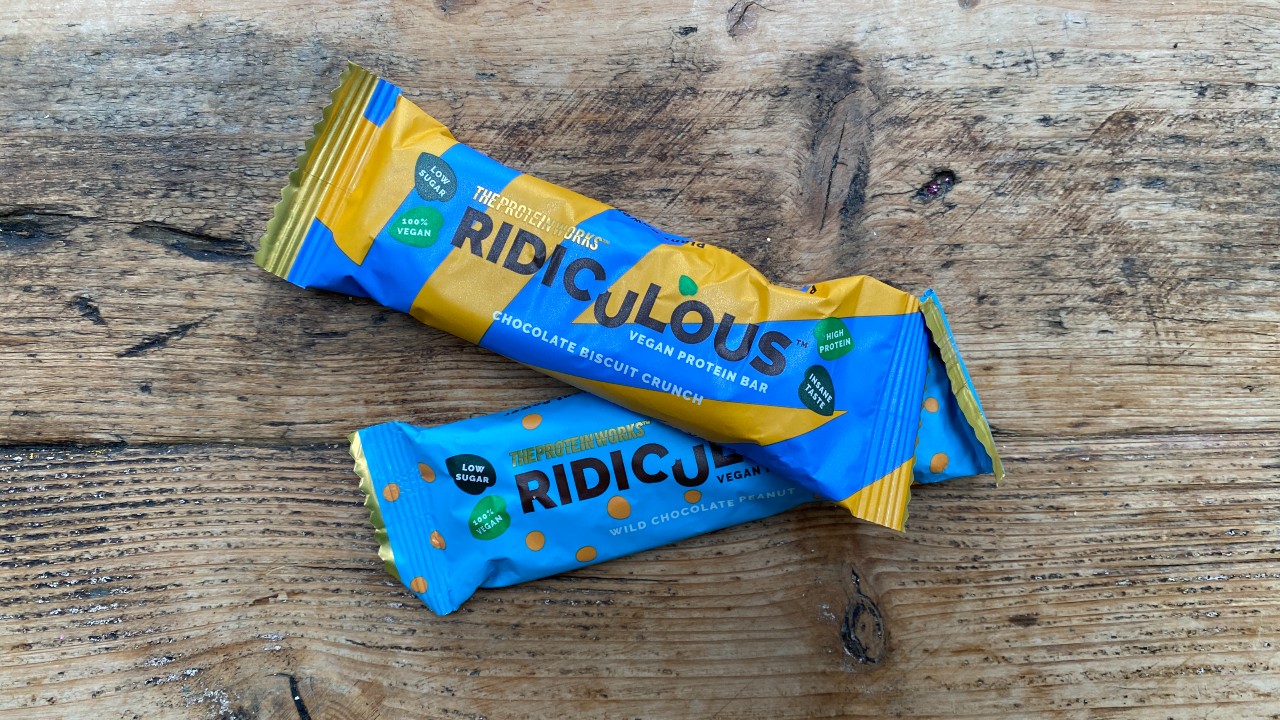
23. The Protein Works Ridiculous Vegan Protein Bar
Specifications
Reasons to buy
Reasons to avoid
Our favorite flavor: Wild Chocolate Peanut
Aside from the somewhat zany packaging, there’s nothing especially ridiculous about this protein bar. But that’s no bad thing—do we really need ridiculous protein bars in our lives? The various flavors contain no surprises—chocolate features heavily across the range—and all are satisfying and tasty, with layers of biscuit, nuts and caramel.
The fine details: There’s 15g of protein in each 47.5g bar, along with a substantial 7.6g of fiber. The carb content is a little higher than other bars at 10g, which is good for refueling after energetic gym sessions. The calorie count of 197 is low though, and there’s just 0.8g of sugar in each bar, with stevia used to sweeten them.—NHF
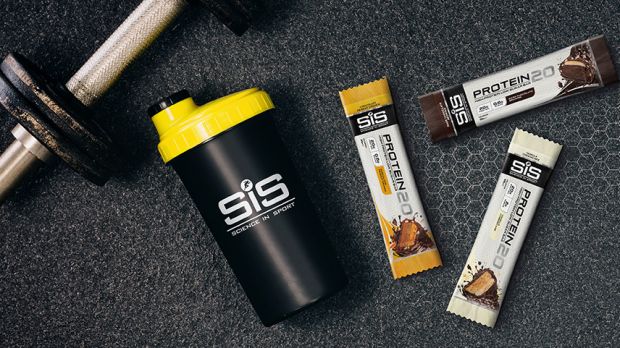
24. SiS PROTEIN20
Specifications
Reasons to buy
Reasons to avoid
Our favorite flavor: Chocolate Peanut Crunch
All the bars in SiS’s PROTEIN20 range have opted for a “party on the top, business on the bottom” approach, in that there are fun crunchy nuggets above the layer of slightly stodgy, presumably protein-packed filling. The chocolate peanut crunch is the most flavourful of the range, though for our money it’s still a little too bland to work as a replacement for a chocolate bar.
The fine details: Each 55g bar contains 20g of protein and 216 calories. The sugar count is kept to just 2g, with polyols used to sweeten the bar. These are carbohydrates, but not sugars, so the carb total is higher than in many other bars at 22g, which is no bad thing in our view—after a tough exercise session refueling with carbs is important.
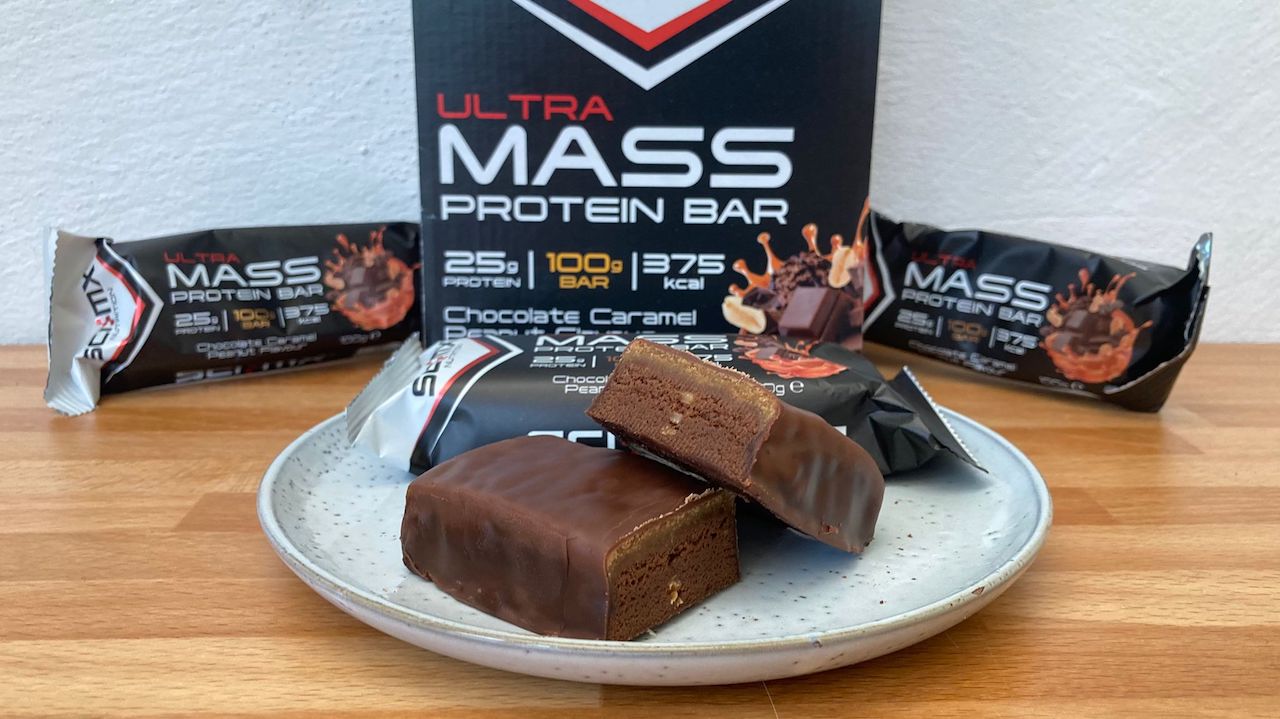
25. Sci-Mx Ultra Mass Protein Bar
Specifications
Reasons to buy
Reasons to avoid
Our favorite flavor: Chocolate Caramel Peanut
In contrast with the jaw-breaking protein bars of old, Sci-Mx’s soft and squishy brick-shaped snack has minimal structural integrity, making it incredibly easy to eat. The chocolate caramel peanut flavor is extremely sweet, without much caramel, and the peanut chunks were a welcome inclusion. For me, it’s too sweet to eat every day, but I found it useful for chucking into my bag when I was on the go and running low on fuel.
The fine details: Unlike most health snacks, this beefy bar is designed to provide a decent dose of carbs (45g) and calories (375) alongside a generous 25g helping of protein. This is handy for people who live an active lifestyle and need to fuel themselves on the go, or those who are looking to pack on muscle mass. However, the 27g serving of sugar is notably high.—HB
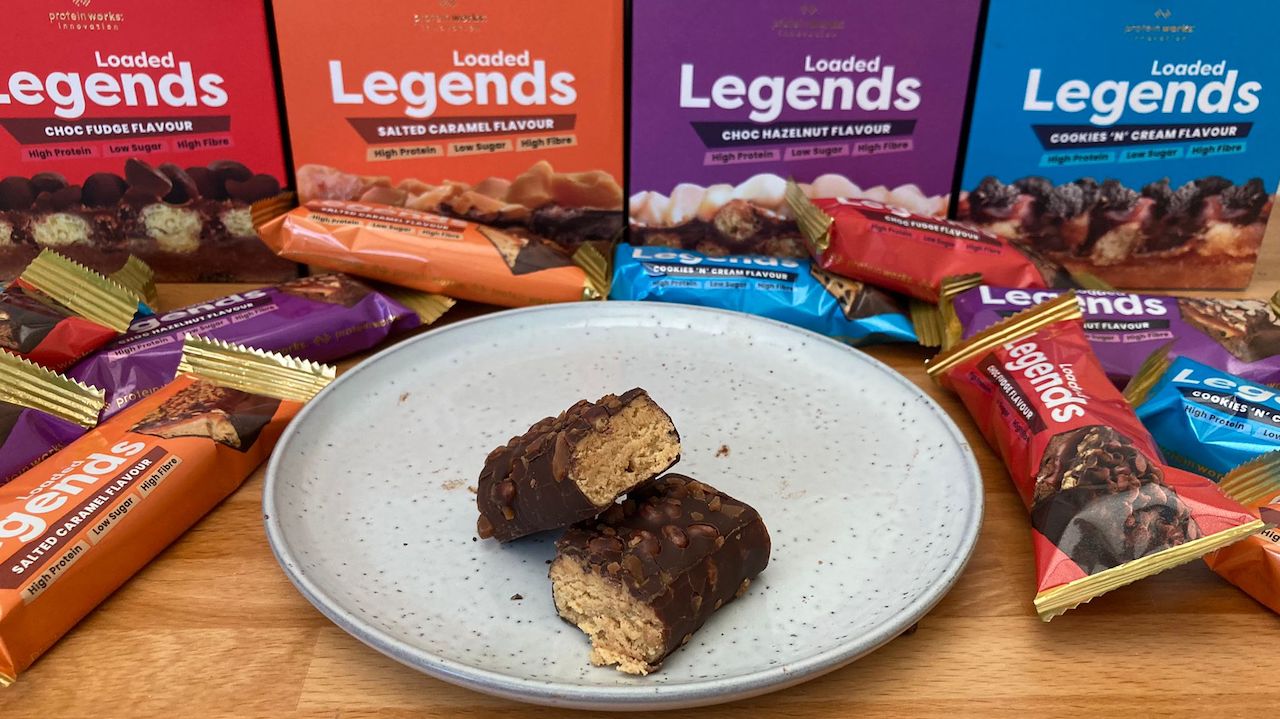
26. Protein Works Loaded Legends
Specifications
Reasons to buy
Reasons to avoid
Our favorite flavor: Chocolate Hazelnut
Unlike most protein bars, there’s no weak link among the four Loaded Legends flavor options. Chocolate hazelnut was my highlight, although that’s down to personal preference. Each one tastes great with various crumbled toppings, and a filling that layers crispy and smooth elements for a really enjoyable eating experience.
The fine details: This is a well-balanced bar that works well as a quick snack. It’s lower in fats, sugars, carbs and calories than many competitors, and also offers a healthy (if not huge) 14g protein top-up to help you hit your daily quota.—HB
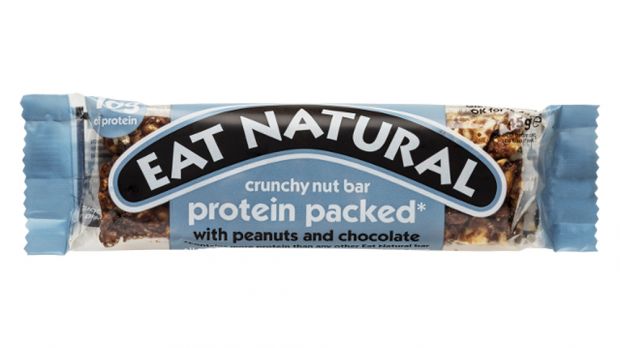
27. Eat Natural Protein Packed
Specifications
Reasons to buy
Reasons to avoid
Our favorite flavor: Peanuts And Chocolate
Unlike supplement companies who move to protein bars from protein powders, Eat Natural have a snack bar heritage which means its protein offering should be especially tasty. And it is – it tastes like a crunchy cereal bar, with chunks of dark chocolate and coconut. The catch is that you get a lot less protein...
The fine details: Just 10g of protein per 45g bar, under what most people like to put away straight after a heavy workout session. As a way to top up your protein intake during the day, however, Eat Natural bars are a better snack than biscuits or cake, but keep an eye on the sugar—each bar contains 8.4g. Finally, the fiber—a decent 3.3g per bar.
Protein Bars Buyer’s Guide
Before you start grabbing fistfuls of bars it’s important to know what you should be looking for. The headline is obviously how much protein they contain, but as with all processed food you have to be careful to avoid hidden nutritional nasties. To help determine what you need to check, we enlisted Kurtis Frank from nutrition and supplement encyclopaedia examine.com.
What should people look for when choosing a protein bar?
“The main factors for choosing a protein bar would be taste, macronutrient composition—how many carbs, proteins and fats there are—and price,” says Frank.
Most protein bars will deliver somewhere between 15g and 25g of protein. Beyond that, you want to look at how much protein you are getting per calorie.
“For macronutrient composition, most bars are either just under 200 calories while giving 15g of protein or are around 250 calories for 25g of protein,” says Frank.
“Both these options are good for overall health and performance since, at the end of the day, they should only be making up a small percentage of your total calories.”
Also make sure you are actually buying a protein bar, not a general energy bar that’s aimed at endurance activities where loads of carbs are required.
“There are quite a few performance bars out there, such as Clif bars, that are meant for snacks during athletics such as biking or hiking,” says Frank.
“They're pretty much all carbs so they don’t work as a protein bar to eat at work or between meals.”
The price of protein bars can vary hugely, and there will be monstrously bad ones at the cheaper end of things. However, if you can find a cheap bar you like, it will obviously help you save money and there are bargains available, especially if you shop online.
“When it comes to price, a premium protein bar can easily be one of the most expensive things in your diet on a per-calorie basis,” says Frank.
“They aren’t cheap, but the cheap ones also tend to taste worse and be made with poorer ingredients so it ultimately ends up being a balancing act based on your preferences and how much you are willing to spend. It is always worth it to at least try the cheaper bars since they might taste good to you and end up saving you money.
“Aim to get a decent amount of protein per calorie and don’t spend too much money unless you need to. If you’ve found a brand you really like then consider buying in bulk online as you can save a lot that way.”
What difference does the type of protein make?
Protein brands will offer many varieties in their bars, and the terms used can be pretty confusing for the layman. Luckily, it shouldn’t matter too much which protein is in your bar.
“The different types of protein matter much less in a protein bar than they do in shakes,” says Frank, “since the rate of absorption for proteins are inherently slowed when put into a solid form and paired with dietary fats and fibers.
“The types of protein with higher biological values [the percentage of the protein that is absorbed by your body] are still technically better but ultimately they're all close enough that debating about milk protein concentrate versus whey isolate is irrelevant.”
A couple of things you should look out on the label is whether there is a high amount of gelatine or soy concentrate, says Frank.
“The only real ways that the protein type is relevant is if there is a high gelatine content, which provides amino acids and appears as protein on a nutritional label but is not a nourishing protein type, or if you're getting 30g of soy concentrate, since in high doses there could be a mild oestrogenic effect [ie it will raise your levels of oestrogen, the female sex hormone] and 30g of the protein is a pretty high dose. Keep in mind soy lecithin is not soy protein and is totally fine in a protein bar.”
Should you be wary of calories and sugar in protein bars?
It’s easy to view your protein bar as a healthy snack, especially as you’ll regularly eat it before or after a gym visit and won’t be so concerned about keeping tabs on your food. However, they can contain more calories and sugar than you might expect, as we found out in our taste test.
“You definitely should be worried about calories and sugars in protein bars,” says Frank, “just as much as you would with candy bars. Just because it can be seen as healthy doesn't make its consumption a free pass to be omitted from your dietary logs or calorie counts.”
On the other hand, you can also pick up protein bars that contain unexpected health bonuses, especially when it comes to upping your fiber intake.
“It is usually a good idea to get at least 5g of dietary fiber in a protein bar,” says Frank. “It helps it go down better, and a lot of us need help to get a decent amount of fiber in our diets.”
What else should you look out for in a protein bar?
Reading the label on protein bars won’t tell you anything about the texture. The worst of them can be rock-hard and leave you chewing for hours.
“Whether or not it can be used as a brick cannot easily be conveyed through the label,” says Frank. “It will ultimately require some taste testing to find out which ones can break a window when thrown.
“Sugar alcohols like sorbitol and xylitol are more common in the cheaper protein bars that are looking to reduce calories by swapping natural sugars out for these ones. While they can be consumed in moderation and aren't necessarily bad, they can definitely cause gastrointestinal upset in some people. If you're eating a protein bar before exercise, this is the last thing you want.”
Get the Coach Newsletter
Sign up for workout ideas, training advice, reviews of the latest gear and more.

Nick Harris-Fry is a journalist who has been covering health and fitness since 2015. Nick is an avid runner, covering 70-110km a week, which gives him ample opportunity to test a wide range of running shoes and running gear. He is also the chief tester for fitness trackers and running watches, treadmills and exercise bikes, and workout headphones.
- Harry BullmoreStaff writer
- Jonathan ShannonFormer editor
